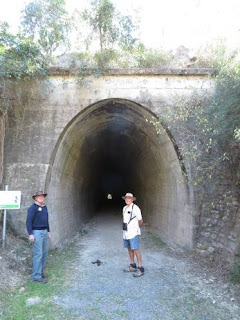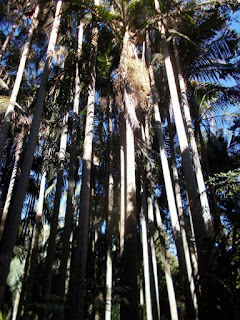At 7.30am
sharp, nineteen Field Nats, including our driver Phil Haxen, departed by bus
from the Neil Street car park bound for Ambrose Treacy College, Indooroopilly.
On arrival we met up with Lesley Beaton and John Ball, who had travelled
independently. The focus of our visit was Brother’s
Gully.
An article by
Alexander Davies entitled Brother’s
Gully: A story of habitat regeneration increasing biodiver-sity, in the
June 2019 edition of “Metamorphosis” the Magazine of the Butterfly and Other
Invertebrates Club (BOIC) had alerted Ben Gundry to the potential of the
Gully for a visit. To quote from the article: “Brothers Gully is a patch of sub-tropical riparian rainforest
adjoining mangroves, located at the south western end of Ambrose Treacy
College, Twigg Street, Indooroopilly, Brisbane. The Gully area starts at the
top of Kate Street, Indooroopilly, and stretches 140 metres till it reaches the
riverbank”.
The Gully is
the subject of a weeding and revegetation program, initiated in 2015 by a Year
11 student, Alex-ander Davies, with support from the school and his
grandparents, Trevor and Tina Lambkin. Alexander, our guide for the morning,
had been motivated by the sight of this small remnant area of riparian
rainforest becoming choked by exotic weeds. He told us that revegetation of the
steep Gully is also supported by the Brisbane City Council under its Land for
Wildlife program, and free plants from the Moggill Creek Catchment Group (MCCG)
and Save our Waterways Now (SOWN) nurseries. But the weeding and planting is
all done by students (Gully Men) under the direction of Alexander.
We were
impressed by Alexander’s knowledge of both the flora and fauna as he guided us
around different sections of the Gully, some relatively advanced and others
still being cleared in readiness for planting. Over 180 (mainly local native)
species of ground cover, understorey, mid-storey, and canopy plants have been
grown to enhance the existing vegetation. An increasing number of birds,
mammals, reptiles, and invertebrates have been recorded since commencement of
the project – a reflection of the plant species selected.
After a
leisurely lunch on a wide deck overlooking the river, we departed for the
Sherwood Arboretum, to be joined by Tricia Allen and her grandson. On arrival
we were met by Brisbane City Council volunteer Guides, Dick and Jankees. Opened
on 21 March 1925, the heritage-listed Sherwood
Arboretum covers an area of 15 hectares, contains approximately 1,100 trees
from about 300 species, and comprises parkland, artificial fresh-water wetland
and has an extensive frontage to the Brisbane River.
Of particular note is an avenue of Queens-land Kauri Pines (Agathis robusta) planted for the 1925
opening.
Splitting into two groups, we followed our knowledgeable
guides as they identified fine specimens of native trees, some local and others
from further west that were familiar to many of us. A boardwalk along the Bris-bane
River introduced us to three species of Mangrove. A very comprehensive
description of the Arboretum is available on Wikipedia and interested readers
are encouraged to access it for further information.
Leaving at 4.00pm Phil drove us safely back to
Toowoomba, where we arrived at 5.30pm after an enjoyable day blessed with
perfect weather
(Report by Deb Ford)
Plus Dusky Moorhen & Barred Cuckoo-Shrike
 |
| Brown Huntsman Spider, Heteropoda jugalans,
family Sparassidae, at Brothers'
Gully (Photdo: Francis Mangubhai) |
 |
| Avenue of Qld Kauris at Sherwood Arboretum (Photo by Diana Ball) |
 |
River mangrove flowers and salt crystals on the leaves (Photo: Diana Ball)
|













